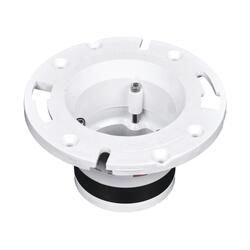Here underneath you will find lots of brilliant data in relation to How to Repair a Toilet Flange.

Introduction:
Understanding the Importance of a Toilet Flange:
In the realm of plumbing, the often-overlooked commode flange plays a crucial duty in making certain the seamless operation of your washroom components. As a crucial connector in between your bathroom and the underlying waste pipe, the toilet flange functions as the unrecognized hero of your plumbing system. Without this durable element, your bathroom would be prone to instability and leaks, potentially leading to costly repair services and hassle. For that reason, comprehending the value of a properly set up and maintained bathroom flange is paramount for any home owner embarking on plumbing projects or attending to fixing demands.
Why Proper Installation and Maintenance Matter:
Correct installation and meticulous maintenance of the toilet flange are essential for protecting the stability of your plumbing facilities. A carefully installed flange not only supports your toilet firmly in place however also develops an impervious seal, fending off the perils of leaks and smells. By embracing a positive technique to flange upkeep, you can mitigate the risk of disruptive plumbing concerns and maintain the tranquillity of your household setting. Throughout this informative overview, we'll decipher the ins and outs of toilet flange installation and fixing, empowering you with the knowledge and experience to navigate these crucial jobs adeptly.
Ideal Practices When Installing a Toilet Flange:
Guaranteeing a smooth commode flange setup calls for adherence to a set of ideal methods that assure resilience and performance. Begin by diligently assessing your tools and products, guaranteeing you have the essential tools for the task ahead. Picking the ideal flange product, whether PVC, ABS, or cast iron, is vital, as it figures out the longevity and efficiency of your plumbing component. Additionally, evaluating existing plumbing problems, such as checking for damages or rust, is important for preemptively addressing prospective problems and making certain a smooth setup procedure. By adopting these primary measures, you established a strong foundation for a successful bathroom flange setup, reducing the chance of future problems and helping with long-term upkeep.
Once properly prepared, wage the careful removal of the old flange, following an organized technique to stay clear of creating damages to bordering parts. Employ methods tailored to deal with stubborn or rusted flanges, ensuring their swift and secure removal without compromising the stability of the bordering plumbing framework. With the old flange got rid of, diligently mount the new replacement flange, choosing one that fits comfortably and firmly right into place. Correctly protecting the flange to the floor making use of screws or adhesive is essential, as it makes sure security and avoids future leakages. By adhering to these ideal methods during the setup procedure, you lay the groundwork for a durable and reliable commode flange setup that stands up to the examination of time.
Setting Up a New Toilet Flange:
When mounting a new bathroom flange, the very first step is to choose the ideal substitute for your plumbing setup. Consider elements such as the material of the flange, with alternatives consisting of PVC, ABS, or cast iron. PVC flanges are known for their cost and resistance to deterioration, making them a popular choice for DIY enthusiasts. Abdominal flanges offer similar advantages to PVC yet boast included durability, making them appropriate for high-traffic locations or business setups. Cast iron flanges, renowned for their strength and durability, are suitable for installations where sturdiness is extremely important. Additionally, ensure that the replacement flange is correctly sized and fits well right into area to produce a watertight seal and protect against leakages.
Securing the Flange to the Floor:
Once you've chosen the appropriate replacement flange, it's vital to safeguard it effectively to the flooring to ensure stability and prevent future issues. Begin by positioning and aligning the flange correctly over the drain, ensuring that it rests flush with the flooring surface. Depending upon the type of flange and your specific installment choices, you can secure the flange to the flooring making use of screws or sticky. If utilizing screws, make sure to use corrosion-resistant choices to prevent rusting with time. Additionally, adhesive can supply a safe and secure bond in between the flange and the flooring, ensuring a durable and trusted installment. By adhering to these steps and taking the necessary preventative measures, you can set up a new bathroom flange with confidence, making certain a resilient and leak-free plumbing fixture.
Ideal Practices When Repairing a Broken Flange:
Repairing a broken bathroom flange demands precise focus to detail and adherence to finest practices to make certain a long lasting solution. Begin by extensively analyzing the level of the damages and recognizing the underlying reason, whether it be corrosion, fractures, or imbalance. This analysis will certainly assist your fixing strategy, permitting you to pick one of the most appropriate strategies and products for bring back the flange to its optimum problem. Additionally, take into consideration the surrounding plumbing facilities and flooring stability to attend to any type of possible contributing factors and prevent future issues from arising. By performing a comprehensive analysis and analysis, you lay the groundwork for a reliable and long-lasting repair work process that deals with the root cause of the trouble.
With a clear understanding of the flange's problem and the aspects influencing its damages, proceed with the fixing process making use of accuracy and treatment. Relying on the severity of the damages, you may select fixing approaches such as epoxy putty, repair service flange sets, or partial flange replacements. Make certain that the chosen fixing approach efficiently resolves the specific problems handy while maintaining the structural stability and performance of the flange. In addition, take aggressive measures to strengthen the fixed flange and prevent future damage, such as using sealant or waterproofing materials to safeguard versus leakages and deterioration. By adhering to these best techniques throughout the repair service process, you can recover your damaged flange to optimum condition, guaranteeing the long-lasting reliability and performance of your plumbing system.
Kinds Of Toilet Flanges:
Understanding the various sorts of commode flanges is essential for choosing one of the most ideal option for your plumbing requires. PVC, ABS, and cast iron are amongst the common products used in commode flange building, each offering distinctive advantages and factors to consider. PVC flanges, known for their cost and deterioration resistance, are favoured for their simplicity of installation and longevity. Abdominal muscle flanges, comparable to PVC in regards to price and simplicity of setup, are treasured for their effectiveness and resistance to effects. On the other hand, cast iron flanges, renowned for their extraordinary stamina and durability, are commonly liked for high-traffic locations or business setups where longevity is extremely important. By acquainting yourself with the characteristics of each product, you can make an educated decision when choosing a bathroom flange that aligns with your specific needs and choices.
Along with material factors to consider, bathroom flanges likewise come in various design and styles to fit various plumbing setups and installment choices. Offset flanges, for example, are made to fit commodes set up on floorings that are not level or where the waste pipe lies off-centre. In a similar way, repair work flanges, additionally referred to as repair rings or spacer rings, are made use of to attend to problems such as fractured or broken flanges without the demand for extensive plumbing modifications. Furthermore, flexible flanges supply versatility ready, permitting exact placement and fit throughout installment. By checking out the varied range of toilet flange kinds and designs offered, you can pick the choice that finest matches your plumbing configuration and installment demands, ensuring a smooth and reputable remedy for your bathroom fixtures.
Specialized Options:
Along with standard bathroom flanges, there are specialized alternatives available to attend to particular plumbing obstacles and installation preferences. One such choice is the countered flange, which is designed to suit toilets installed on floorings that are uneven or where the drain is located off-centre. Balanced out flanges include a distinct design that enables the commode to be placed at a minor angle, making up for uneven flooring or misaligned plumbing links. This innovative service ensures a safe and steady installation, removing the need for pricey and time-consuming floor progressing or pipe relocation. By incorporating a countered flange right into your plumbing setup, you can get over common installation barriers and attain a professional-quality outcome with ease.
An additional specialty choice worth thinking about is the fixing flange, additionally called a repair work ring or spacer ring. Repair flanges are specifically made to deal with issues such as fractured or damaged toilet flanges without the need for extensive plumbing modifications. These functional components can be set up straight over the existing flange, providing a strong and reputable base for safeguarding the toilet in position. Repair flanges come in different dimensions and setups to suit different flange diameters and installment needs, making them a convenient and economical option for fixing flange-related problems. Whether you're dealing with a small flange fixing or a much more complicated plumbing problem, integrating specialty options like offset and repair work flanges can streamline the installation process and guarantee resilient performance for your restroom fixtures.
Conclusion:
To conclude, mastering the art of bathroom flange installation and repair is vital for preserving a practical and leak-free plumbing system in your home. By recognizing the value of an effectively set up flange and sticking to ideal methods throughout the process, you can make certain the longevity and integrity of your shower room components. Whether you're picking the right type of flange, carrying out fixings, or discovering specialized options, interest to information and meticulous implementation are crucial. Normal upkeep and aggressive repairing can assist protect against pricey plumbing concerns and protect the serenity of your family atmosphere. Armed with the knowledge and abilities obtained from this comprehensive guide, you can tackle toilet flange setup and repair service with confidence, encouraging you to secure your plumbing system for years ahead.
TOILET REPAIR HOW TO REPLACE A BROKEN TOILET FLANGE
First remove the toilet. Turn off the water line, flush the toilet, and remove the water line from the bottom of the toilet tank. Have bucket handy, as water will come out of the tank. Sponge out as much water from the tank and bowl as you can. A handyman trick is to use a wet dry shop vac to suck all the water out of the bowl and tank.
Remove the nuts on each side of the base of the toilet. These nuts-bolts attach the toilet to the flange. You may have to use a saw to cut the nuts off, which is ok, because you are going to put in new toilet bolts and nuts. The flange, when brand new, is attached to the waste pipe. Many times it rusts or snaps off. Tilt the toilet on its side and move out of the way. Have a helper assist you in moving the toilet, they are heavy and bulky.
Use a putty knife to remove the wax ring residue from the exposed flange and inspect the flange and surrounding area. What is key here is if the wood subfloor is rotted. If this is the case, you will have to cut out the surrounding subfloor and replace it with new plywood, then fix the flange.
Thankfully on this home improvement project, the subfloor was fine, just the flange fell apart. Go to your hardware store and buy a Super Ring Replacement Toilet Ring. There are several models by different suppliers, don't buy the cheapest one, its your toilet, remember...
Also at the hardware store buy new toilet mounting bolts, they usually come in a package with the nuts and washers.
Put the toilet mounting bolts in the flange pointing up, and use some wax from the old wax ring to hold them in place. Place the super ring replacement toilet ring over the waste line, making sure the mounting bolts are in the same place as the original bolts were, one bolt on each side of the flange.
Screw the new flange into the subfloor. You may have to use a hammer drill to drill through existing tile flooring or cement substrate. Set the new toilet wax ring onto the flange on the base of the toilet, and guide the toilet back onto the super ring, making sure the toilet mounting bolts are lined up with the mount holes in the toilet base. The super ring toilet ring allows for you to adjust the location of the bolts.
https://www.gardenfork.tv/toilet-repair-how-to-replace-a-broken-toilet-flange/

I am very curious about Toilet Flanges and I'm hoping you enjoyed reading the blog posting. Do you know about someone else who is curious about How To Install a New Toilet Flange? Why not promote it. Bless you for your time. Please pay a visit to our blog back soon.
Book Service
 Luke Perry Then & Now!
Luke Perry Then & Now! Rider Strong Then & Now!
Rider Strong Then & Now! Patrick Renna Then & Now!
Patrick Renna Then & Now! Danica McKellar Then & Now!
Danica McKellar Then & Now! Lynda Carter Then & Now!
Lynda Carter Then & Now!